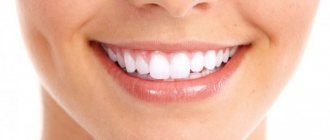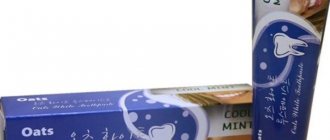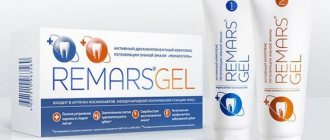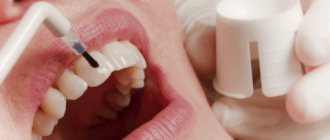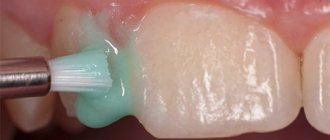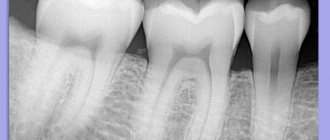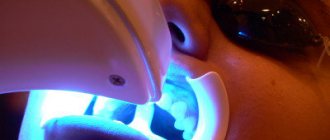Operating principle
Plaque that forms daily contains a huge amount of bacteria. By releasing acids of various compositions, bacteria destroy the enamel, as if dissolving the calcium molecules in it, and thereby deprive it of its protective properties. The compounds included in the RemarsGel complex have the ability to gradually penetrate the tooth enamel and replace lost calcium. “RemarsGel” actually “repairs” the area of tooth enamel that has lost its strength, strengthens it and helps restore the natural protection of the tooth.
During the process of brushing teeth with “RemarsGel”, calcium nitrate from tube No. 1 is mixed with ammonium hydrogen phosphate from tube No. 2. As a result of a safe chemical reaction, a brushite crystal is formed on the surface of the teeth, similar in composition to the main component of tooth enamel (hydroxyapatite crystal). Due to its small size, the brushite crystal penetrates deeply into tooth tissue, restores enamel damaged by caries, closes microcracks and quickly relieves tooth sensitivity (even after professional whitening). After a course of using RemarsGel, the enamel becomes smooth and shiny, and a feeling of smoothness of the surface of the teeth appears, as if after polishing.
Method of using remineralizing agents
A mouthguard helps.
Since the active substance is applied to the inside of the onlay and fits tightly to the teeth after it is installed, a remineralization tray is considered the most effective way to carry out the procedure. The only nuance is that you first need to purchase to order or make at home (there are such options) your own individual set of onlays for the teeth. It is recommended for an adult to wear a mouthguard with a medicinal composition on the teeth for no more than 30 minutes. After the procedure, it is better not to eat or drink for another half hour.
Without the help of a mouthguard.
If there are no individual pads, a regular toothbrush, brush or applicator from the kit will help. Remineralization gel, mousse or cream is usually applied after brushing the teeth and should remain on the enamel surface for up to 1 hour. After the procedure, in most cases there is no need to rinse your mouth with water.
At a young age, special attention should be paid to the condition of the enamel, since the enamel of newly erupted teeth is not sufficiently saturated with minerals and is therefore easily damaged by acids.
It is necessary to consult a dentist during the period of changing teeth. The specialist will select a suitable product for home care of the child’s teeth and prescribe a series of professional procedures.
Basic recommendations
Be sure to use RemarsGel 1-2 times a day. Both treatment and prevention must be strictly daily! "RemarsGel" can be used both at home and for treatment in a dental clinic.
The course of treatment of tooth enamel consists of 20-28 procedures. In case of visible damage to the teeth, “RemarsGel” should be used every day until the enamel is restored, and then – to consolidate the action of the complex 1-2 times a week.
For preventive effects, 10-14 procedures are sufficient. The prophylactic course of “RemarsGel” is recommended to be carried out 3 times a year.
Gels for self-application on teeth and gums
Gels intended for home applications comprise at least two different groups.
Gels containing fluoride
(up to 4000-12000 ppm fluoride ions), used
for applications to teeth
in order to intensify their secondary mineralization, remineralization and increase the resistance of enamel to acids. Often the gels are acidified, since the incorporation of fluoride into the enamel occurs more actively in a slightly acidic environment. They can be intended for individual use at home or for use in a dental office (Fig. 7). Thus, these means of local caries prevention relate to both personal dental care and medical dental prophylaxis.
Fluoride gels available for self-use
include neutral sodium gel (5000 ppm), stannous fluoride gel (1000 ppm). 1.23% sodium fluoride acidified phosphate gel (APF) has become widely used. Below is the classic composition of such a gel:
- sodium fluoride - 26.50 g
- sodium phosphate (dibasic) - 10.00 g
- phosphoric acid 50% (until pH = 3.2 is reached)
- 11.00 ml
- sodium carboxymethylcellulose - 28.00 g
- sodium saccharin - 500.00 mg
- flavoring – 10.00 ml
- distilled water - up to 1 l
In some European countries, topical gels are used as part of mandatory dental brushing programs (6–12 times a year) or are recommended for weekly home use in persons over 8 years of age. The concentration of fluoride in self-administered products is lower than that in products intended for professional use.
Applications are usually carried out not daily, but at certain intervals.
To carry out the application, the gel is applied to the teeth using a toothbrush or applicator for several minutes, after which the mouth is thoroughly rinsed. Application with gel applied to an impression tray or a special two-jaw plastic tray is more effective and safe. Many companies produce application spoons of various sizes for this purpose. It is more convenient to use individually made spoons. About 2.5 ml (5-10 drops) of gel is usually applied to an adult’s spoon (about 40% of the spoon’s capacity).
Gels for home use, just like toothpastes, can be involuntarily swallowed (according to various sources, from 15 to 100%, on average 30%), therefore the fluoride content in them corresponds to that in traditional fluoride-containing toothpastes. Gels with a high fluoride content can only be used in a clinical setting under the supervision of a physician and using a saliva ejector.
The duration of the application should not exceed 4 minutes. If you have porcelain dentures in your mouth,
which can be destroyed by acidic solutions and gels, they should be isolated (lubricated with Vaseline) before application. Before applying the gel, you must brush your teeth, 30 seconds after application, rinse your mouth with water or a saturated sodium bicarbonate solution, and do not drink or eat for 30 minutes.
Fluoride gels for individual and medical use are indicated in case of high intensity of caries, the presence of general and local cariogenic factors (in particular, according to WHO recommendations, orthodontic patients and in patients with xerostomia who are undergoing radiation therapy), the presence of foci of enamel demineralization on the teeth, and dental hyperesthesia.
Gels intended for application to the mucous membrane of the gums,
represent an extremely small group. These, in particular, include drugs with antiseptic and anti-inflammatory additives used before and after periodontal surgery.
This group also includes Oralbalance Gel, containing lactoperoxidase, glucose oxidase and xylitol. Like Biotene toothpaste, the gel replenishes the normal protective properties of saliva, reducing bacterial contamination. Due to the content of polyglyceryl methacrylate, the gel moisturizes tissue and is recommended for use in cases of xerostomia. The gel is applied to the tongue and gums. It is not recommended to combine with detergents.
Parodium gel (Pierre Fabre, France) contains chlorhexidine digluconate (0.02 g), Tangut rhubarb extract, which has an anti-inflammatory effect (0.20 g), formaldehyde (0.10 g) and is applied with a finger or a special applicator to the gums 3 times a day. day for the prevention and treatment of periodontal diseases.
Dentim-gel (Mirra, Russia) contains biologically active substances isolated by cold extraction and biotechnological potentiation from a special collection of medicinal plants, lavender essential oil, and alcoholic extract of sweet clover. The gel has antibacterial, anti-inflammatory and deodorizing effects and is recommended for application and gentle rubbing into the gums for preventive purposes in the presence of inflammatory processes in the periodontium.
Clinical study
RemarsGel is a product that has the unique ability to restore damaged or weakened tooth enamel that is ready for damage; it was originally called Remogel. Research on this drug took place at the Department of Pediatric Therapeutic Dentistry of the Moscow State Medical and Dental University. The purpose of the test was to determine the compliance of the Remogel gel with the possibility and feasibility of its use in dental institutions of the Russian Federation.
During the test, the simplicity and accessibility of the method of using the gel was revealed, and a pronounced remineralizing effect of the gel on foci of demineralization in caries was established. The study showed that Remogel successfully passed medical tests and can be recommended for widespread use in medical practice.
Dissertation of Doctor of Medical Sciences Volkov Evgeniy Alekseevich:
“Pathological changes in the hard tissues of teeth often begin with focal demineralization, leading to dental caries and its complications, as well as non-carious lesions, accompanied by dentin exposure and hyperesthesia. Therefore, mineralization of enamel and dentin, elimination of focal demineralization and hyperesthesia of teeth are a measure for the prevention of more severe pathological processes... A new generation of domestic dental materials and new methods of mineralizing therapy for the pathology of hard dental tissues with the material “BV” (for clinical use - approx. “Gekom”) and a set of gels “Remogel” (now “RemarsGel” - note by “Gekom”) were introduced into practical healthcare at the industry level (included in the State Register).”
Features of the procedure
Fluoridation (remineralization) is one of the most common methods of strengthening teeth and an excellent alternative to the once popular silvering procedure. It helps prevent caries in children of any age. Fluoridation is relevant for both permanent and baby teeth. It increases the resistance of enamel to cariogenic factors and prevents the development of serious dental pathologies. Doctors recommend this procedure for children starting at the age of 5. It is prescribed during the period of growth of baby teeth, during a change in bite and with enamel hypersensitivity.
When should you see a doctor?
- increased sensitivity of teeth,
- pain when brushing teeth, eating solid foods,
- acute discomfort due to exposure to any irritants - hot, cold or spicy food,
- uneven enamel surface - the presence of chips, cracks, roughness and even depressions,
- discoloration of enamel - when it becomes thinner, dark dentin shows through,
- congenital or acquired enamel hypoplasia.
Strengthening teeth: 5 reliable methods
Expert opinion
Elina Ruslanovna Dzagurova Dentist-therapist Work experience 9+
“Our center practices an integrated approach, because it is the combination of several techniques that can significantly reduce tooth sensitivity and strengthen tooth enamel. The patient himself needs to do a lot of work – be sure to monitor his diet and use the right hygiene products.”
Enamel remineralization
Remineralization of teeth is the restoration of the mineral composition of tooth enamel, for which special medicinal compositions are used. They are applied to the teeth (including using mouth guards) and held for several minutes. A number of drugs are activated by exposure to ultraviolet light or electrophoresis (electrical pulses). The course of such treatment and prophylactic procedures can last from 3-4 to 20 days. Before they are performed, careful removal of plaque and tartar is required.
For remineralization, Apadent Pro paste with nano-hydroxyapatite is considered one of the most effective preparations, which allows you to restore the structure of teeth in the presence of foci of demineralization, including superficial caries.
Fluoridation of enamel
Fluoridation differs from remineralization only in the composition of medicinal preparations. In this case, gels and ointments are also used, which are applied to the outer surface of the teeth. However, most of their composition is occupied by fluorine and calcium, which significantly strengthen the enamel, making it stronger and more resistant to external influences.
Proper hygiene
The patient himself needs to more carefully monitor his oral hygiene and be sure to change his dental care products. The general rules are that the brush should not be too hard (during the period of exacerbation, you can change it to a soft one, but not for long - it will not cope with plaque). When brushing your teeth, do not put too much pressure on your teeth - this leads to trauma to the enamel.
During the period of weakening of the enamel, you should choose special pastes that reduce tooth sensitivity. However, you do not need to use them constantly - 1-2 times a year for a month.
Proper nutrition
The process of remineralization of enamel can be carried out at home - all you need to do is change your diet. Milk and fermented milk products (cheese, yogurt, kefir), greens, strawberries (contain a large amount of vitamin C), green tea will be useful. You should consume as many foods as possible that contain calcium1 - it helps strengthen tooth enamel.
You can take calcium in the form of medications 1-2 times a year. However, do not forget about the simultaneous intake of vitamin D, which promotes the absorption of calcium and fluoride in our body.
Dental restoration
Dental restoration is an extreme measure that is used in case of hypoplasia or destruction of tooth enamel, because the internal tissues of the tooth may be exposed. In this case, it is extremely necessary to protect them from external irritants. The most reliable option would be to install veneers and lumineers - thin overlays on the front surface of the teeth, which allow you to change the shade, align the position of the teeth, transform their appearance and, of course, protect the enamel from negative external influences.
